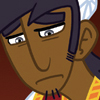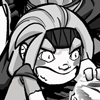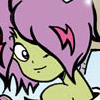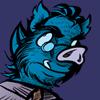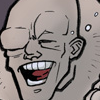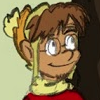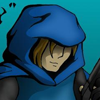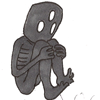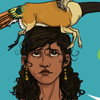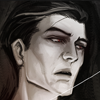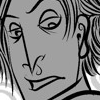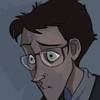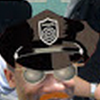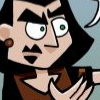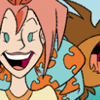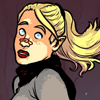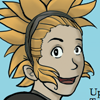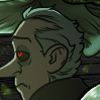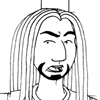Category Archives: Who Are You
Who Are You?: An Interview with Dale Beran and David Hellman (A Lesson Is Learned But the Damage Is Irreversible)
Imagine the world of Dream of a Rarebit Fiend. It’s a world not unlike that of Little Nemo, only rather than mimes or dragons or other childlike pursuits the dreams are more adult in nature. And not the good kind of adult. More like the adult world of anxieties and awkwardness and responsibility. It’s a bizarre world that don’t follow logic, and each panel feels like you’re struggling through a sea of molasses. The big difference is that, in the end, you don’t wake up in bed, cursing about eating that last cheese sandwich. (Something that the Mythbusters proved wasn’t the cause of surreal Winsor-McCay-ish nightmares, anyway.)
I’ve read A Lesson Is Learned But the Damage Is Irreversible some years back. While feeling fresh and new in a webcomic world where humor was about video games and roomies and lotharios, there as something achingly timeless about a strip that seemed to be hewn from 19th-century style woodcuts and taken to the same surreal flights of fancy that would one day inspire Salvador Dali. It isn’t hard to imagine a comic like this getting a wide national release in the early 1900’s just because William Randolph Hearst took a liking to its oddball humor.
A Lesson Is Learned burned brilliantly between 2004 and 2006. The two creators, Dale Beran and David Hellman, then went on to other projects. The comic, while never that mainstream, was also never forgotten, and its return in 2012 was positively met with much joy among webcomic fans. Over at Fleen, Gary Tyrrell wrote: “If not the most widely-read webcomic that ever existed, it was surely near the top of the personal enjoyment list of people that make their living doing webcomics.”
In a set of questions sent by e-mail, The Webcomic Overlook tries to crack the code to what makes ALIL work.
WCO: OK, so… explain the longest title in webcomics: A Lesson Is Learned But The Damage Is Irreversible.
Dale Beran:
This was David’s phrase. At first we were going to make a cartoon. I think it was going to be about baby animals? I don’t know. Then we decided it would be a comic because “that would be easiest” and that it should just be about us because “that would be easiest”. We regarded the name problem as at best as a stumbling block, at worst, an insurmountable boulder which would turn back our creative endeavors for all time. I was just out of college. David was finishing. This was like, our, first real thing or something.
I came up with some horrible names I’m glad we did not name the comic. We were sitting in David’s room and David read the phrase, “A Lesson Is Learned But The Damage Is Irreversible” out of one of his old sketchbooks. We both laughed. We added it to the list and decided to choose it because it was too long and by all measures the most problematic.
David Hellman:
At the time, I was in the habit of scrawling random free-associative phrases in my sketchbooks. Often surreal, fatalistic, and authoritarian. Sort of like the stuff you’d find in Stanley Donwood’s album art for Radiohead. I remember sitting on my bed and turning the page and reading that phrase, and we both laughed. Dale is telling the truth – we picked it in part because it seemed the most problematic. Too long to be a web address. But despite its awkwardness, once you pick your way through it, it does mean something. The first half is a hopeful platitude, lilting and alliterative. The second half lands more heavily.
WCO: To me, the comic is an exercise in stream of consciousness thinking, something that I think is pretty personal. And yet, it’s done by two gentlemen: yourself and David Hellman. How do you split the responsibility?
Dale:
Some of what I write I get through a stream of consciousness technique, but not much. I think almost every writer has had that experience where he or she is falling asleep and his or her thoughts suddenly coalesce into a perfectly worded lock and key for creative expression. And if you are dedicated, you wake up and record them. But most of the time unconsciousness, where everything is like that but you can never take it back with you, is more inviting. Then, the next morning I wake up and labor over a few sentences all day that are not as good.
For every comic I will write about four scripts. David then chooses one to draw. There are “stage directions” in the script. They are generalized descriptions of actions and the way things appear, but not instructions on how to draw the panels (i.e. “third panel is a close up”). We’ll talk throughout the process as I am writing and the David is drawing and offer each other advice. But generally, he is in charge of everything visual and I am in charge of the words and what happens.
Read the rest of this entry
Who Are You?: An Interview with Henry Kuo (Just The First Frame)
Finding new webcomics is a daunting business. As any two people what their favorite webcomic is, and — outside of “What’s a webcomic?” — you’re likely to get two very different answers. There are many, many webcomics out there, almost as many as the grains of sand on the beach, and sifting through them is a chore. We often settle on comics that are recommended to us, but rarely do we find a gem out there on our own.
Recommending webcomics online has its challenges, too. The nature of the internet means that anyone can just download a panel and post it anywhere. The problem, though, is when no one gives credit or a link to the original comic. Webcomic creators collect money mainly through advertising, and losing revenue when someone posts a panel outside their site can really hurt a struggling artist… and that’s something that most webcomic readers don’t want. Things came to a head not too long ago when someone developed a webcomic reader app, only to become the target of angry webcomic creators and supporters.
At the same time, though, webcomic creators, especially those with 20K viewers or less, need all the publicity they can get. There’s so much out there competing for our eyeballs.
Enter Just The First Frame.
Creator Henry Kuo put together a fairly elegant system: post a small snippet of a comic. (Or “just the first frame,” as the URL says.) If it manages to catch your eye, you click on the image and it directs you to the site. If you only want to read the comics that are popular, there’s a handy feature that sorts the comics based on how many people are reading it. The readers get a simple, visual way of browse numerous webcomics without leaving the main page. The webcomic creator doesn’t lose revenue, because the entire comic is only available on their site. Everyone wins!
I recently asked the hard working site master about the inner workings of Just The First Frame. Here’s what he had to say:
WCO: With the number of webcomics out there likely beyond the tens of thousands, do you find maintaining your site to be a little daunting?
Henry Kuo: I’m only including and updating comics that have been suggested to me, so it stands at 586 right now. Early on, I had concerns about how I would maintain the site as the number of comics quickly grew, but every once in a while, I would find something simple to make the process quicker, and I’d be confident I could keep up even if it grew to X amount of comics. I think I could comfortably handle about 1000 right now, but beyond that, I’m not completely sure what I would do.
WCO: Have you ever had to reject webcomics from the site based on content, artistic skills, etc.?
Kuo: The only comics I’ve rejected are ones that are NSFW. Other than that, I don’t really want to be a gatekeeper on what gets included and what doesn’t. I just don’t feel it’s my right to say yay or nay based on my personal opinions. As long as it’s a web comic, I’m more than happy to include it. I did add a link beneath each panel that lets you hide specific comic series, so everyone can do their own personal filtering.
WCO: What has the response been like from webcomic creators?
Kuo: I’m honestly very honored when an artist suggests their comic to my site, and I’ve received nothing but gratitude back in return. In the beginning, I was ready to remove the site entirely if there was any negative feedback, but the reaction was quite the opposite and I was and still am very humbled by it.
Actually, there were a few complaints about the use of the word “frame” instead of the correct term “panel”, and I take complete responsibility for that error, but I just kind of liked the alliteration of the F’s and kept it, though I’ve always been open to change it.
Who Are You?: An interview with Ricardo Porven (Donnie Goth)

Ricardo Porven’s webcomic experiences are fairly unique compared to other attempts. It’s one of the few I know of that’s tried to take advantage of what the media dubs as “Web 2.0.) Last year, Mr. Porven made a splash when he tested the limits of the webcomic format by bringing his comic, Donnie Goth, to Facebook. (Donnie Goth is now available on a non-Facebook website.)
I contacted Mr. Porven last week with a few questions about Donnie Goth, to which he graciously replied.
1.) Mr. Porven… are you or have you ever been a Goth?
I’ve never really labeled myself as part of any group really. I was a teenager in the 80s, a bit before the Goth movement really gained traction. However, in my youth I was known to wear eyeliner and listen to bands like, The Cure, Nine Inch Nails, and Marilyn Manson. I also grew up with a fascination with classic horror movies, the works of Tim Burton, and the comic art of Bernie Wrightson. There was even a time I thought my career would be in special effects make-up and counted Rick Baker as one of my idols. If I had been born a mere 10 years later, I most likely would have considered myself a Goth. So if you met me on the street today, you wouldn’t necessarily identify me with someone who is involved in Goth culture, but personality-wise, I’m pretty much a dead ringer. You could say I wear my black on the inside.
2.) I remember Goths being fairly prominent in the 90’s and early 2000’s. Heck, I remember having a poster of Neil Gaiman’s death on my dorm room walls. However, I haven’t heard much about that particular subculture lately. Are Goths still a thing, or have the gone the way of, say, the beatnik?
The Gothic subculture might have reached it’s height of popularity in the late 90s, but it certainly existed before that and is still thriving today. It’s not a lifestyle that gets the headlines. Those that may have embraced it as a fad have likely moved on to other forms of self-expression, but there will always be a group that identifies with the dark themes, romanticism, and fashion the Goth culture is associated with. This is apparent in the popularity of ongoing Gothic themed-films, including most recently; Dark Shadows, ParaNorman and Frankenweenie. Not to mention the myriad of vampire books, novels, TV shows and films that continue to perform well in the market. It’s a subculture. By definition that means it exists under the radar. I think that’s where it prefers to be.
3.) Donnie started off as as a character who seemed to be bristling with sarcasm. Now he’s more of a lovesick puppy, searching for love among Goths and non-Goths alike. What was responsible for the personality change?
The original strips took place when Donnie was 7 years old. He was this overly dramatic, yet powerful kid who didn’t always make the right decisions. The power kind of gave him a superiority complex in comparison to the other kids in his class and the sarcasm came from an overall disdain he felt for them.
The new strips begin with Donnie being 13 and just starting middle school. Right now, he fluctuates between just wanting to be accepted and wanting to be generally left alone. He spent most of his childhood with just Oliver by his side and he is eager to make friends. I wouldn’t necessarily call him lovesick, but his hormones have definitely become active as a normal part of coming of age.
The one current that runs through all the strips is the fact that things rarely work out on the positive end for Donnie. He is a tragic character, but continues to press on in spite of his misfortunes. And he can still laugh about it (and we can join him). I think that’s something fans relate to, whether you’re a Goth or not.
In the strip “X-massacre”, things begin to take on a more serious tone, and both Donnie and Oliver are in for some long-term adventures that take him way beyond the school environment he has lived in up until now.
I guess, like us, the events in Donnie’s life continues to evolve him as a character and the stories change to reflect that.
Who Are You?: Shannon Wheeler (Too Much Coffee Man, I Thought You’d Be Funnier, Grandpa Won’t Wake Up)
 When you encounter cartoons from the New Yorker, they sometimes seem stodgy. Unapproachable. Indecipherable. Not so with the works of Shannon Wheeler, whose cartoons never fail to hit the funnybone. A few of his cartoons have been published in that grand old magazine. And the ones that haven’t are still fantastic. How do I know this? Because they’re available in I Thought You’d Be Funnier, a collection of Wheeler’s rejected New Yorker cartoons. Maybe they’re not good enough for the New Yorker, but they’re good enough for the Eisner. The book was nominated for the Best Humor Publication Category.
When you encounter cartoons from the New Yorker, they sometimes seem stodgy. Unapproachable. Indecipherable. Not so with the works of Shannon Wheeler, whose cartoons never fail to hit the funnybone. A few of his cartoons have been published in that grand old magazine. And the ones that haven’t are still fantastic. How do I know this? Because they’re available in I Thought You’d Be Funnier, a collection of Wheeler’s rejected New Yorker cartoons. Maybe they’re not good enough for the New Yorker, but they’re good enough for the Eisner. The book was nominated for the Best Humor Publication Category.
The New Yorker isn’t the only place, though, where you can find Mr. Wheeler’s unique brand of humor. Through the magic of email, I got in touch with Mr. Wheeler to shoot the breeze about his various projects.

1.) Who would you say were the biggest influences to your sense of humor and cartooning style?
It really depends on which stage of life that we’re talking about. I loved Garfield (before I could read) but by 5th grade I was reading Edward Gorey and Mad Magazine. Sergio Aragones was one of my favorites. Somehow I got ahold of a bunch of Fabulous Furry Freak Brother comics around 7th grade. Kyle Baker’s Cowboy Wally is still one of my favorite books of all time.
2.) Where do you draw your inspiration for your comics?
My own life is the best inspiration. When I’m able to distort and refashion personal experience into a cartoon I think the work turns out the best. Of course, being on deadline, I still have to produce even when I’m not inspired. Then I turn to fear, exhaustion, and coffee for inspiration.

3.) Too Much Coffee Man comic, the “coffee-themed superhero parody with existential themes,” strikes me as being uniquely zen and surreal. Which, frankly, was kind of a pleasant surprise since I was expecting different things from a comic entitled Too Much Coffee Man. So it’s about a guy dressed up as a superhero (of sorts), a liberal sprinkling of coffee references, and existential humor. How did you end up with such an unlikely mish-mash of characteristics?
I was drawing a cartoon for the Daily Texan. It was pretty much a nondescript autobiographical strip with existential themes. I struggled to describe it to people. I was sitting in a coffee shop trying to come up with something that would be easier to describe. I thought I needed a character with some sort of hook or handle… a visual pun was born.
4.) Speaking of superheroes: you’ve been involved with quite a few superhero-related projects, including a short story in Strange Tales 2. Why choose Red Skull as a protagonist?
I love villains. They’re the true underdogs – even if they’re stronger you know they’re going to lose. I can’t help but root for the tragically flawed and tragically doomed. And there’s something about imagining the Red Skull living in South America (like old Nazis are want to do) that makes me laugh.
Who Are You?: An interview with Ulysses “Seen”‘s Robert Berry
 Adapting a book to fit the comic/graphic novel/sequential art form is a fairly daunting task. So you’ve got to hand it to anyone for adapting one book which, on face value, doesn’t seem like a natural choice to lend itself to a comic adaptation: James Joyce’s Ulysses. Yes, the very same book that’s probably been the subject of the most “impenetrable novel” jokes outside of War and Peace. Who would dare such a foolhardy challenge?
Adapting a book to fit the comic/graphic novel/sequential art form is a fairly daunting task. So you’ve got to hand it to anyone for adapting one book which, on face value, doesn’t seem like a natural choice to lend itself to a comic adaptation: James Joyce’s Ulysses. Yes, the very same book that’s probably been the subject of the most “impenetrable novel” jokes outside of War and Peace. Who would dare such a foolhardy challenge?
Rob Berry, that’s who.
With Ulysses “Seen”, Berry bravely undertakes the task of adapting the 265,000 word novel for the internet. It turns out, though, that the webcomic form is but the first step. Recently, the Ulysses “Seen” app went live at iTunes, taking advantage of the latest in cutting edge technology to bring the acclaimed classic into the new Digital Age of Mobile Technology.
Lately, he’s been working on a new web-based media project with Gary Epting on Story Clouds, which will be seeing some fresh material following Bloomsday.
Rob and I got in touch via Twitter first and, after some rather enthusiastic exchanges, later by e-mail. I asked him about Bloomsday, his favorite scene from the novel, and his experiences with iTunes.
1.) So what is it you do on Bloomsday? Do you dress in any wacky outfits? Visit favorite haunts?
Well, I’m not much of a “dress-up-kinda-guy” but I do collect costume stuff for most of the projects I work on. Still got a full Captain America suit from a series of paintings I made 15 years ago. For Ulysses “Seen” I’ve been collecting hats just to get the look right. But I’d never wear them in public. Nothing says “art geek” like wearing a bowler on Bloomsday and, well, people get enough of that idea when the hear me talk. No sense broadcasting louder.
Berry’s Captain America Pagliacci
This Bloomsday I’ll be in NYC for a lot of fun Joycean events ending with Symphony Space’s 29th Bloomsday on Broadway. And I suspect there will be some drinking involved at some point as well.
2.) Is there any scene in Ulysses you could say stuck out to you or you could call your favorite?
There’s a moment when Mr Bloom is having his lunch and thinking about the first time he made love to his wife. Thinking about a picnic long ago on a hilltop, about them kissing and passing food to one another in that kiss, between there mouths, while he eats his own modest lunch now alone in pub. He knows his wife’s lover will visit her in few short hours and feels there’s nothing to be done about this. And he watches “stuck on the [window]pane two flies [buzzing], stuck.”
To me this one has always been a really vivid image that works exactly the way comix do and film does not. The idea of visual information combined through there juxtaposition but not necessarily connected in time.
3.) Joyce fans are pretty hardcore. What’s been the reaction of Joyceans to your adaptation — positive or negative?
Joyceans can be, in their own way, much more dogmatic than Trekkies. Cracking the code of Joyce’s puzzles within the book is tricky business, so really nuanced arguments prevail about what the author is really telling us. People feel an involvement with text once they’ve made it through and an investiture in telling others what they may’ve missed. It’s quite natural, really. There’s so much information in there for people to dig through.
But Joyce, plagued by terrible eye problems, is often cited as being a very “non-visual” writer. There aren’t a lot of flowery descriptive passages in there but a lot of room for argument. So most all of the comments I get from Joyceans are actually really a help to me for purposes of research. They really do know this novel waaaay better than I and I’d never be able to do it without their help and interaction.
That being said, I’d probably describe their reaction as “supportive but cautious.” Oh, and maybe “sometimes sermonizing.” Most want to encourage me in doing this, but also feel I’ll never make it or, worse yet, go horribly astray from the true path.
Read the rest of this entry
Who Are You?: An interview with T Campbell (Penny & Aggie, Divalicious!, and others)
 If you spend any time with webcomics, chances are you’re going to run into something written or created by T Campbell. Mr. Campbell’s flagship work is the high school drama Penny & Aggie (reviewed here), which he co-created with artist Gisèle Lagacé. Yet, this comic writer has done much more: Rip & Teri, Search Engine Funnies, Cool Cat Studio, and the long-running Fans! Along with artist Amy Mebberson, he created Pop Star for the “Rising Stars of Manga” contest at TOKYOPOP, which would later become the comic known as Divalicious! T also co-created the webcomic transcription tool Oh No Robot with Ryan North of Dinosaur Comics.
If you spend any time with webcomics, chances are you’re going to run into something written or created by T Campbell. Mr. Campbell’s flagship work is the high school drama Penny & Aggie (reviewed here), which he co-created with artist Gisèle Lagacé. Yet, this comic writer has done much more: Rip & Teri, Search Engine Funnies, Cool Cat Studio, and the long-running Fans! Along with artist Amy Mebberson, he created Pop Star for the “Rising Stars of Manga” contest at TOKYOPOP, which would later become the comic known as Divalicious! T also co-created the webcomic transcription tool Oh No Robot with Ryan North of Dinosaur Comics.
I contacted T by e-mail, and he was very gracious about answering several questions I had, including a few about a project that he nowadays regrets: his book, A History of Webcomics.

T Campbell (left) in a tense hostage situation.
The Webcomic Overlook: You wrote A History of Webcomics, which was published in 2006. Now, I haven’t read it, though I have followed its progenitor, the History of Online Comics essays at Comixtalk. What in the world compelled you to take on that project?
T Campbell: Idiocy? Hubris? Maybe I was just tired of being moderately respected by my peers.
Just as well that you’ve read those essays instead of the book, because they were much better-received, and, to my mind, much better. The book took the idea too far, and I wound up alienating a lot of people I respected, all for a project that I can’t even look at today. I still sort of like my old fiction, where the amateurishness gives it a goofy charm, but if I could burn every copy of that book I’d be happier and live longer.
WCO: I keep trying to imagine how you managed to compile the information for your History of Online Comics series, and I get a headache… especially when I think about the material from the earliest chapters. How in the world did you manage to gather that information?
TC: Though I looked at books and magazines, most of my research came from the Internet itself, and from interviews. (The Internet Archive is great for recovering lost information, up to a point.) If you do get a copy of the book, you’ll see it has a thick endnotes section. That’s one of the few things I still like about the book: at least I cited my sources and made it easier for someone else to do a good book when the time is right. They should have been footnotes, not endnotes, but oh well.
One of the criticisms of the book that I have come to agree with is that I didn’t rely enough on interviews. If I absolutely had to do it all over again, I would have socialized more and exercised more patience. And published around 2020.
WCO: Even though it’s only been 2 years or so since the book was published, things have changed a lot in the world of webcomics. Are you considering publishing an updated edition?
TC: Good God, no.
I was thinking about it when the book went to press, which is why it’s labeled “v1.0,” but that was when I was still deluding myself that the problems were minor.
I did a couple of webcomics-coverage projects in the years after History: the “Blowing Bubbles” podcast interviews, and an earlier version of webcomics.com. They were not earth-shattering, but they were a big improvement. But by that point, not many people cared.
These days, I’m happy to focus on scriptwriting, and readers seem happy for me to do so, too.
Who Are You?: An Interview with Neil Kleid (Action, Ohio)
 What if superheroes, created by analogues of Stan Lee and Jack Kirby, were real and based on actual people with powers? What if they were hidden away in a sleepy town since the 1950’s? And if there are superheroes, are there supervillains?
What if superheroes, created by analogues of Stan Lee and Jack Kirby, were real and based on actual people with powers? What if they were hidden away in a sleepy town since the 1950’s? And if there are superheroes, are there supervillains?
Action, Ohio, written by Neil Kleid and illustrated by Paul Salvi, was originally one of the hopeful competitors trying to win a contract with Zuda Comics. The comic follows heroine Andi Bruce, a Detroit detective with a sad past, who is compelled to solve a brutal murder. Her investigation gradually leads her to learn about the existence of superheroes in a town on the Michigan-Ohio border. Eventually, she must decide between solving her case or protecting the heroes’ freedoms by keeping things quiet.
I first encountered Action, Ohio, when Jack, Anthony, The Doctor, Delos, and I did a round of reviews at Comic Fencing. I heard about the comic again when Neil sent out a press release that the comic had moved to Shadowline, an Image Comics affiliate that begun publishing webcomics in October 2008. I did some quick research, and it quickly dawned on me that Neil Kleid was prolific. Winner of a Xeric Award (for Ninety Candles), writer for several print comics published by NBM to Slave Labor to Image, art director for Comedy Central and Miramax campaigns, creator of several webcomics…. Good God, y’all.
A large sample of his work can be found at his Rant Comics site.
I contacted Neil if he’d like to do an e-mail interview, and he graciously accepted. Neil had already conducted two excellent interviews with Newsrama and io9. I wanted to touch on subjects that hadn’t yet been covered at the other sites: what it was like working for Zuda and Shadowline, what common themes were within his body of work, and … why Ohio?
WCO: Action, Ohio, has been hosted on Zuda Comics (an affiliate of DC), and Shadowline (an affiliate of Image). Some independent webcomic artists, like Spike from Templar, AZ, insist that the benefits of self-publishing are more rewarding. You’ve seen both sides of the story, having worked on the Late Night Block and Todt Hill at The Chemistry Set. What are the advantages with working at Zuda or Shadowline?
Neil: Well, right off the bat there’s the same advantage of self-publishing versus working with a place like Oni, Dark Horse, Vertigo, etc — the fact that you don’t need to deal with the administrative end of things. Don’t have to worry about hosting fees, don’t have to deal with maintaining the site and so forth. More importantly, though, you get NAME CACHE. See, name cache is important — especially when you’re trying to focus eyes on a new product by new talent. In the sea of self publishing, out in the deep waters of the back half of the Diamond Distributor catalog, trying to get a new comic book noticed is nigh impossible unless you’ve got NAME CACHE — i.e., there’s a name talent on the book or you’re connected to another book or publisher that has a name. New Avatar titles use “from the publisher of Alan Moore, Warren Ellis, Garth Ennis, etc.” and Oni books get a bit of reflective shine from SCOTT PILGRIM. It’s a itme honored tradition and it works, especially when you get right down to it and realize that the Diamond catalog ain’t all that big.
The internet, however, is freaking infinite. Scoring hits to your webcomic, when coasting the void on your own, is a trial. You need to be creator, editor, publisher, advertiser, marketer and PR guy all in one. Many can handle it — you got your Jeph Jacques, your Scott Kurtz, your Gabe and Tycho, R. Stevens and more. When your comic is hosted on a publisher-connected hub, though, you can focus on THE WORK and let the name cache bring viewers in. A webcomic on the Shadowline hub has the advantage of being connected to a) Image Comics b) Jim Valentino c) excellent cartoonists like Carla McNeil, Trudy Cooper and others. Getting in with the Zuda crowd means that you’re part of the Warner Bros/DC Comics media machine and surrounded by well known webcomics like HIGH MOON, BAYOU, NITE OWLS and more. Plus, you know, you get paid.
And at the end of the day, should your webcomic flourish at either site, odds are pretty good on a print collection.
Now, sure — you can do all that on your own if you’ve got the moxie and business sense. Personally, I’m not a businessman nor a marketing machine. I like to write comics. I like creating them within nurturing, friendly studio environments which is why I’m with Shadowline. For me, being able to be on the hub is happiness enough. Everything else is gravy.

WCO: Have you seen any big differences between how Zuda and Shadowline run things, from the standpoint of corporate culture, editorial influence, etc.?
Neil: Besides the fact that Zuda pays a rate and Shadowline is all back end, if anything?
Yeah… there’s a lot more freedom at Shadowline. Jim and Kris Simon tend to be pretty hands off when it comes to editorial influence vis a vis the webcomics. As long as the comic is awesome, go with god. They see something in each webcomic they add to the site and trust in the creators to shepherd the strip to its potential awesomeness.
Read the rest of this entry
Who Are You?: An Interview With Albone (Alan Evans)
 Alan Evans, known as Albone on his site, writes a comic with what I consider one of the most unconventional premises in webcomics today: Rival Angels. How unconventional? In his review, Ambush Bug of AICN said, “One of the coolest things about comics is that they can be about just about anything, especially webcomics, which don’t have to deal with uptight execs thinking about trends and expectations in the marketplace. In this medium, the artist/writer doesn’t have to worry about all that and can just tell the tale he wants to. Here’s such a concept: female professional wrestlers.”
Alan Evans, known as Albone on his site, writes a comic with what I consider one of the most unconventional premises in webcomics today: Rival Angels. How unconventional? In his review, Ambush Bug of AICN said, “One of the coolest things about comics is that they can be about just about anything, especially webcomics, which don’t have to deal with uptight execs thinking about trends and expectations in the marketplace. In this medium, the artist/writer doesn’t have to worry about all that and can just tell the tale he wants to. Here’s such a concept: female professional wrestlers.”
In particular, Rival Angels follows the struggles of the high-flying blonde-haired, starry-eyed hero, “Ultra-girl” Sabrina Mancini, as she tries to prove her skills in the ring while navigating murkier political waters backstage. What follows is a lot of brawls, a lot of backstabbing, and a lot of redemption.
I relished a chance to do an interview with Alan Evans. Partially to talk shop, but mainly to chat about a shared passion for the warriors of the squared circle.

Alan Evans (right) and women's wrestler Gail Kim.
An Interview With Albone (Alan Evans)
WCO: Wrestling comics do not have a good track record among comics in general. A couple, like the Kevin Nash and Ultimate Warrior comics, have been inducted into Wrestlecrap.com. What do you think these comics did wrong? How do you hope to sidestep their errors in Rival Angels?
Albone: In every instance, including the Undertaker and Kane comics, they strayed away from wrestling. It’s like having Jeff Gordon in a space thriller with space race cars to get around while they’re meeting new life forms. Lex Lugar trying to blow up a boat with Sting on it, showed up in WCW’s comic. Really?! Wrestling will always be the milieu of Rival Angels. Sure, the girls might do things that aren’t wrestlerly at home, or out on the town, but they’ll always be wrestlers in a wrestling federation and I think that’s why it will succeed where those others have failed.
WCO: In your comic, wrestling is presented as a total shoot. It’s more like an MMA match, what with the outcome not being predetermined and the characters taking their rivalries off-camera. Any reason you decided to go this route?
Albone: It felt more entertaining to make the ring action real. For the most part, wrestling in our lifetime has been scripted so this is a way to present a fresh take on pro wrestling, while taking a cue from the rising popularity of MMA. From a character point of view I think it makes them more interesting and I think readers outside of pro wrestling will appreciate that realism.
WCO: In the Rival Angels universe, why would anyone, like the Hell’s Belles, decide to go heel (bad guy)?
Albone: Heel’s are usually revealed through their actions. Normally, they don’t pick to be a heel, their ring work dictates it. For instance, the Hell’s Belles didn’t decide to be heels (they usually think they’re right), actions like bashing fan favorites in the head with a chair chooses that. However, many wrestlers do promote their heel-ness. There’s a certain freedom to it that allows them to break the rules and get away with it (most of the time). There are a few wrestlers that are just natural jerks though and play it up for the negative attention it gives them.

WCO: Women’s wrestling is big time in other countries… Japan and Bolivia come to mind. But in the US, it’s usually takes a backseat eye-candy role to the men’s wrestling. In fact, ignoring a brief resurgence in TNA Wrestling (when Gail Kim was anchoring the division) and minor federations like Shimmer, it’s practically non-existent. So why do a comic about female wrestlers?
Albone: You hit the nail on the head with the current state of women’s wrestling in America. Because women’s wrestler is so neglected here, it seemed to be the more interesting road to take. Men’s wrestling is huge, so it’s pretty easy for one to find it. Women’s wrestling is a little harder to find and so, a bigger canvas for me to work with, so to speak. The creative freedom using women over men makes it that much more appealing.
Read the rest of this entry









